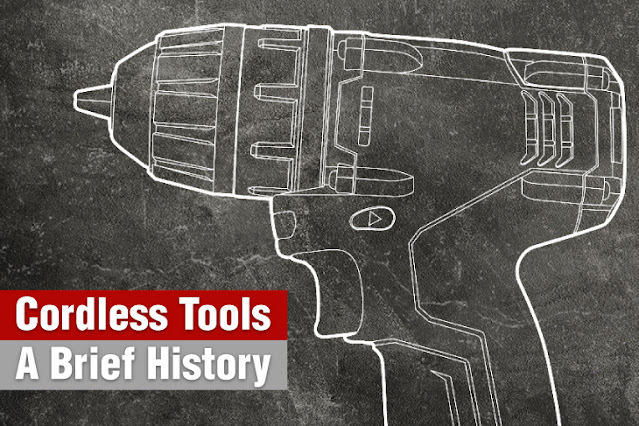Cordless Tools: A Brief History
In a wide range of activities like construction, gardening, DIY, carpentry, plumbing, and so on, tools are fundamental to get your job done. If we go back in time, 3.3 million years ago to be exact, the greatest technological advance was the hammer. Hand tools as we know them now were invented by people who faced problems; for which they found practical solutions. Today, we can work with like thousands of hand tools, power tools, stationary and cordless tools with unique qualities, thanks to incredible advances in technology. The diversity in tools is mind-blowing and I think there’s no need to classify them here. These tools help us in cutting, rotating, rectification, clamping and many more. In this unending tally of names, we also find cordless tools; seemingly new tools that work with batteries. In this article, I like to give some information about fascinating history of cordless tools along with introducing some of new advancements in this field. So, let’s start.
The Very Beginning of a New Development
After invention of the
electricity, the potential of this new power source was known immediately and
new tools were invented based on it. Marking a new milestone in the
history of tools, power-based tools have come to greatly
facilitate the completion of various tasks, reduce work time, and decrease
worker fatigue. The different electric tools such as circular saws,
screwdrivers, drills, grinders and rotary hammers among many others, are
adapting their design to the diverse needs of users. That is why in the market
we can find countless models of the same power tool. If you are interested in
history of tools, you can read about the invention of first power tools in
this article: “A Tool Odyssey: History of tools from
prehistory to the present”
screwdrivers, rotary hammers,
drills, grinders, carwashes, saws, among many others, are also classified as electric
tools. They can be corded, which must be connected to an electrical network in
order to function, or cordless tools like cordless screwdrivers
and cordless drill-drivers, which work with batteries.
Cordless Tools: How Did It Begin?
The first cordless tool was designed and manufactured by Black & Decker in 1961. This was the beginning of a new era in the history of tools. The innovation was exciting; it was big enough to convince Martin Marietta Corporation to contract Black & Decker for designing cordless tools for the Nasa’s Apollo space exploration program. However, a Japanese company was the first tool company that designed a cordless drill for the general public.
Cordless tools can be considered as an
evolution of their corded version. Cordless tools allow you to do the
same job but provide a set of advantages that cannot be provided by traditional
power tools. You can find some of these advantages below:
·
Ease of mobility, portability and
maneuverability.
·
They can be used in areas without electrical
connection.
·
They facilitate work in hard-to-reach spaces.
·
They allow to carry out the work more safely
at heights, and in humid environments.
While they provide additional
benefits to your corded pair, there is no cordless tool suitable for all
jobs. That’s being said, not all corded tools have their wireless version, yet.
Cordless Tools - One Step Ahead
The ongoing advancements in technological
features of cordless tools are so rapid that are not comparable with other
kind of tools. Some tool
manufacturers, like Ronix, have designed a whole line of products that
are compatible with the same battery. In
other words, users can use different work instruments with the same battery,
saving money and time. For example, you can use same batteries for Ronix 8612, 8510, 85128512S, and 8525 Cordless
Drill/Drivers.
But the story doesn't start
here. Decades earlier, when the electric drill first appeared, many
manufacturers began to flourish. In 1924, A.H. Peterson developed a
lightweight, portable drill that could be operated with one hand, a product
that Milwaukee Electric Tool Co. got the license when it was just getting
started and later improved upon. Milwaukee produced more durable and powerful
corded and cordless drills specifically for professional tool
users. -Another pioneering brand is Bosch, which launched its first cordless
drill in 1978. Cordless tool technology took a major turn in 2005 thanks
to Milwaukee lithium-ion batteries. Changes in batteries forms and
technologies, made it possible to have more compact and durable tools.
Some of the most notable
features of the new batteries are:
·
Batteries can be used with different tools.
·
Resistant to all kinds of damage.
·
They can be combined to obtain more power.
·
They are flexible and expandable.
·
They use sustainable and ecological
technology.
·
They comply with the most demanding safety and
quality standards.
·
They have high performance and a long service
life.
Power Tools, Corded or Cordless?
Power tools in general, are
great assistants in almost any type of work. However, choosing between a corded
or battery-powered tool depends on the type of the task you want to do.
Corded tools continue to be
the best choice for high power demand and long run-time jobs. However, battery-powered
tools are ideal for jobs in which excessive use of the machine is not
required, and for those tasks that must be carried out in inaccessible spaces
and most of the time without electricity.
Although at the moment the
number of corded tools is greater than the number of cordless tools,
technology finds its way by developing new alternatives in the structure and
functionality of the cordless tools. Some cordless tools
currently match their corded version in power and performance, so we are
confident that we will see new creations and advancements in the near future.
Innovations in Cordless Tools Batteries
The revolution in battery
powered tools continues while manufacturers continually offering better cordless
tools. Bosch, Metabo, Ronix, Hilti, Makita, Dewalt, are some of the well-known
cordless drill manufacturers. It could be said that we are witnessing
the greatest change in the power tool market in history, since suddenly in a
short period of time new Lithium Ion batteries have been developed with much
greater performance than we had imagined. The changes mainly come in battery
power, and all manufacturers are getting involved.
Dewalt, Metabo, Ronix, Hilti,
Hitachi, Husqvarna, Makita and Bosch among other manufacturers are already well
positioned in the professional market. But new manufacturers with
high-performance batteries such as RYOBI, TEENO or TACKLIFE are starting to
emerge, which are carving out a niche in the market, and are leading the super
sales of amazon. The benefits of using cordless tools are enormous: no
polluting emissions, low noise, low vibration, easy operation with simple start
and stop, freedom to go wireless, and at the end, much lower maintenance
requirements. Nowadays, most of the tools are equipped with rechargeable batteries.
Although, the initial cost of a rechargeable battery is much more than a
Nickel Metal hydride, they are
more economical in long run.
The first batteries that were
used for cordless tools were Nickel Cadmiums (NiCd). These batteries
were heavy and their life was very short. They unload quickly and as they lose
their load the machine loses its power as well.
Later, Nickel Metal hydride
(NiMh) batteries are invented. These batteries already had a longer service life,
but they also had the disadvantage that when they were discharging, the tool was
losing its power. Another major disadvantage was that you could not trace the
level of the load. finally, like Nickel Cadmium batteries, they contained
Nickel; a highly hazardous substance to the environment.
Lastly, Lithium Ion (Li-ion)
batteries have invented. These batteries have been a revolution in the field of
cordless tools, and cordless drills in particular. The properties
of Lithium Ion batteries such as the lightness of its components, resistance to
discharge, storage capacity, ability to recharge without deterioration have
made manufacturers more eager to considerably invest in this technology.
With Lithium Ion batteries,
you will get higher performance, lower weight, and more resistance in
comparison with NiCd and NiMh batteries. Therefore, if you want to buy a cordless
drill, I recommend to do not hesitate for a moment and buy a cordless
tool with Lithium Ion (Li-ion) batteries.
Is It Possible to Use a Battery for Different Cordless Tools?
The answer is yes. The same
battery can be used in different cordless tools or cordless drills.
This is the great advantage of this type of technology. With a single battery
you can power different tools, so you reduce the stock of batteries and
facilitate the choice of the tool. Manufacturers of power tools had been
working on a type of battery that can give power and capacity to all types of cordless
tools, and with Lithium Ion batteries they have succeeded.
What About the Future of Cordless Tools?
The improvements on cordless
tools continue and new versions come with various capabilities. Here, I
want to introduce two outstanding battery models. These are samples that show which
features of the batteries are changing mostly and help us to make predictions
about the near future.
The first one, Makita BL1850 battery (18V.-5Ah.), is a great
example of new generation of batteries. Keeping up with the improvements and
new developments, since the end of last year Makita has been offering a 5.0Ah
version (BL1850B Battery) of its 18V lithium ion battery to power a wide range
of its cordless tools.
The new battery has a 55-minute charge time
and a robust cover that guarantee the advanced protection and operating
features. Offering 20% more capacity than the 4.0Ah, it will fit any 18V tool
from Makita. Version 5.0Ah has a new circuit to protect against overcharging,
high temperatures or current surges. It also features a cooling system that
forces air over each individual cell to ensure the longest possible battery
life, while the housing provides shock resistance. The sliding terminal, with
multi-contact connections, allows stable contact between the battery and the
power tool.
Husqvarna is also improving
its choice of 36V batteries. The current choice for professional use includes
the 4.2Ah built-in battery or 5.2Ah, 9.4Ah, 14.4Ah or 26.1Ah backpack
batteries. The firm is ready to introduce an integrated 5.2 Ah battery, followed
by a 9.4 Ah option to give a day of work on a single charge.
This year, we have already
seen Makita introduce the BL1840B battery with a memory chip that stores the
number of charges. Also, this model comes with internal ventilation to increase
performance. This power source provides users with 50 percent more stored
energy compared to Nickel Metal hydride batteries, and can be charged with the
regular Makita DC18RC charger
Battery power is here to stay,
but will we see cordless heavy-duty tools or some battery powered industrial machines?
Surely YES, John Deere has built a prototype. If we look at the automotive
industry a bit, the manufacturer TESLA is making battery-powered vehicles with
excellent results. Therefore, it is clear to me, battery technology has come to
stay and little by little we will see more and more machines powered by
batteries, and consequently there will be a better evolution of batteries.
Moreover, the motors of cordless tools have been improved a lot. The new motors are brushless which make them more powerful and help users to get the advantage of longer run time. The motors are getting more compact, while they get more power to deliver high speeds. I think, no one in their right mind agrees with the idea that, at least in the near future, cordless tools stop developing and will be replaced by other kind of tools.











Comments
Post a Comment